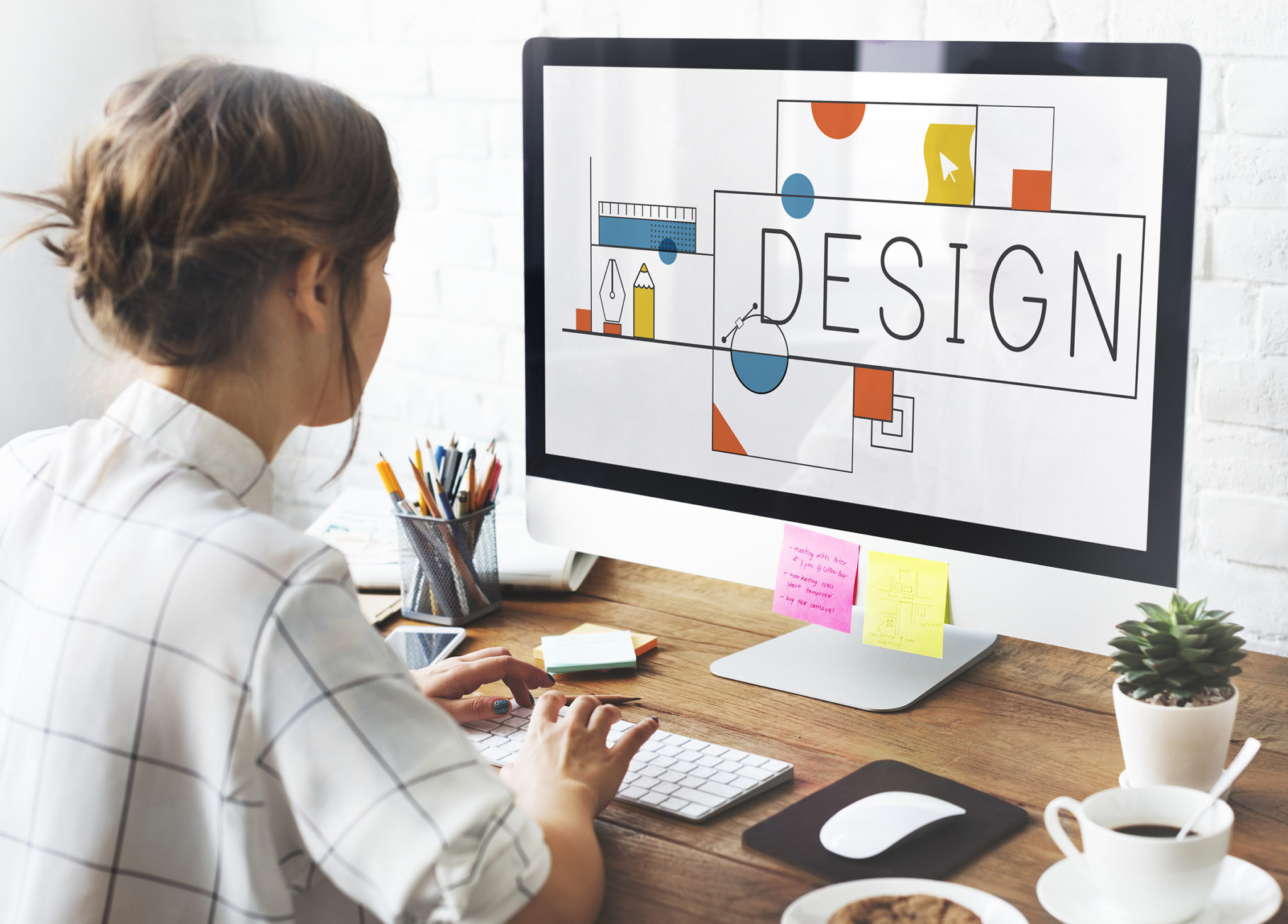Understanding how to become a graphic designer involves obtaining relevant education, building a diverse portfolio, and gaining experience through internships or freelance work. Continuous learning and networking within the industry will further enhance your skills and opportunities.
What Are the Main Types of Graphic Designers?

Graphic designers create visual elements to communicate messages or ideas to a specific audience. They may work on different designs depending on the industry or area of focus. The main types of graphic designers are:
- Brand Identity and Logo Designer: This designer specialises in logos, visual identity, and branding materials for businesses and organisations. The design process centres around creating an overall brand image that represents the company’s values and connects with its target market.
- Web Designer: Web designers focus on making websites visually appealing while providing a good user experience. They are responsible for the look and feel of a website, including layout, typography, colour schemes, and user interface (UI). They often collaborate with developers to implement their designs.
- UX/UI Designer: Designers who work on digital products, such as websites and mobile apps, function as both User Experience (UX) and User Interface (UI) designers. Their goal is to facilitate user navigation and enhance overall enjoyment of the products.
- Print Designer: Print designers create visual content for physical products such as brochures, magazines, posters, business cards, and packaging. They must understand print production, paper types, and layout for physical formats.
- Motion Graphic Designer: Motion graphic designers create animated visuals for video, film, advertising, and online content. They combine graphic design with animation, video production, and sound design to produce dynamic visuals that attract and retain interest.
- Illustrator: Illustrators create custom art for various media, including books, magazines, advertising, and digital content. This may involve hand-drawn or digital concepts and typically requires collaboration with art directors and other creative professionals.
- Packaging Designer: Packaging designers focus on the visual elements of product packaging, such as branding, typography, and design. They work closely with internal design teams and clients to ensure that packaging is both attractive and functional while effectively conveying the brand message.
- Environment Designer: Environmental designers provide visual solutions within physical environments, such as exhibitions, trade shows, retail spaces, and public installations. Their work often crosses the boundaries of graphic, product, interior, and architectural design, focusing on design within architecture and spatial planning.
- Marketing and Advertising Designer: These designers create ads, banners, social media graphics, emails, and other printed or digital materials that promote ideas, products, services, or events. Working with a marketing team, their primary goal is to create visuals that capture the audience’s attention and convey marketing messages.
- Editorial Designer: Editorial designers create layouts for publications such as magazines, newspapers, and books. They combine typography, photography, and graphic elements to ensure the pages are readable and visually appealing.
What Does a Graphic Designer Do?
Graphic designers create visual content to communicate ideas, messages, and information. They use various tools and techniques to develop designs for websites, marketing materials, packaging, and more.
The responsibilities of a graphic designer include collaborating with clients to understand their needs, producing designs for print and digital media, and ensuring that the final products align with brand guidelines. Additionally, graphic designers must stay updated on industry trends and tools, allowing them to innovate and enhance their creative output. Here’s a detailed breakdown of what a graphic designer does:
- Design Concepts: Graphic designers develop design concepts based on the client’s requirements or the project brief. They brainstorm ideas, sketch rough drafts, and create mood boards.
- Laying Out Pages and Creating Graphics: Designers use software to create layouts, illustrations, and graphics for print or digital media, including logos, advertisements, websites, brochures, business cards, and packaging.
- Fonts, Colours, and Images: Graphic designers select fonts, colours, and imagery that align with the project’s goals and branding. Their choices must work together to create a visually appealing and cohesive design.
- Work with Clients and Teams: Graphic designers often collaborate with clients, art directors, marketing teams, developers, and others to create designs that meet project objectives. They receive feedback, make revisions, and ensure designs remain on message with the brand.
- Maintain Visual Consistency: Graphic designers ensure that all visual elements are consistent across platforms and media. This includes keeping colours, typography, and layout aligned with brand guidelines and other designs.
- Tailor Designs for Various Mediums: Whether working on a print piece, website, or social media account, graphic designers must adapt their work for different platforms, resizing images, modifying layouts, or optimising designs for mobile devices.
- Prepare Files for Print or Digital: For print projects, graphic designers create final, ready-to-print files that meet the printer’s specifications; for digital projects, they develop files for the development team.
- Keep Up with Design Trends: To stay competitive in the industry, graphic designers must remain up-to-date with current trends, tools, and technologies. This involves learning new software, keeping abreast of the latest design trends, and knowing what’s popular.
Average Graphic Designer Salary

The salary of a graphic designer varies depending on experience, location, and the type of work they do in the UK. Graphic designers will be paid differently if they are freelancing compared to working full-time in an agency or a corporate firm. Here is a breakdown of a typical graphic designer’s salary:
- Entry-Level Graphic Designer: £18,000-£25,000 per year. These junior positions are often found in small agencies or corporate graphic design departments, where designers work under supervision and learn by doing.
- Mid-Level Graphic Designer: With 2-3 years of experience, salaries range from £25,000 to £35,000 annually. At this level, designers take on more responsibility and may manage projects or junior designers.
- Senior Graphic Designer: Senior designers, who have several years of experience and often supervise projects or teams, earn between £35,000 and £50,000 a year. They may also work more as creative directors with clients.
- Freelance Graphic Designer: Freelance graphic designers typically charge between £25 and £60 per hour, depending on their experience, skills, and the complexity of the project. As a freelancer, you can set your own rates and choose who you want to work with.
Essential Skills of a Graphic Designer
To be a successful graphic designer, you need to possess a range of skills of a graphic designer, including creativity, the ability to organise information, and technical proficiency in using software to create your designs. The following are the necessary skills for a career as a graphic designer:
- Creativity: Designers are often asked to develop new ideas and concepts to communicate a message, making creativity a key component of the role.
- Design Software: Designers use tools such as Adobe Photoshop, Illustrator, and InDesign to create digital content. Proficiency with these tools is essential for creating layouts, illustrations, and other digital materials.
- Typography: Understanding typography is one of the most critical skills for graphic designers. They must choose the right fonts and ensure that the text is readable, visually appealing, and enhances the overall design.
- Colour Theory: Knowledge of colour theory is important for building visually pleasing designs. Graphic designers need to learn how colours work together, what feelings they evoke, and what they communicate to an audience.
- Attention to Detail: Graphic designers must pay careful attention to detail, ensuring that elements like alignment, spacing, and typography are perfect. Even a small error can affect the entire piece.
- Critical Thinking: Graphic designers must think creatively to develop unique, practical designs that meet client needs. They also need to problem-solve when issues arise during the design process. For example, working with challenging clients can be tough; staying calm and professional while addressing their demands is crucial. Strong communication skills can help explain your perspective, making collaboration easier.
- Time Management: Graphic designers often juggle multiple projects, so effective time-management skills are necessary. They need to keep track of deadlines, manage their workload, and prioritise tasks wisely.
- Adaptability: Graphic design frequently involves collaboration, where clients and stakeholders may request revisions or changes to the initial design plan. This requires flexibility and an open mindset to embrace new ideas, working styles, trends, and tools.
Graphic Designer Tips

Here are some practical tips for aspiring graphic designers who want to build a successful career:
- Build a Portfolio: Your portfolio is the most important resource you have for securing a graphic design job. Include your best work, showcasing a mix of styles and various projects. Customise your portfolio for the specific job you are applying for, whether it’s web, branding, or print.
- Keep Up with Design Trends: Design trends are constantly changing, so stay informed by reading design blogs, subscribing to industry publications, and attending workshops or webinars. Knowing what’s current in the design world will keep your work looking fresh and relevant.
- Take Feedback Well: Feedback is an essential part of the design process. When clients, co-workers, and mentors provide critical feedback, take it seriously. Constructive criticism can enhance your designs significantly.
- Work on Personal Projects: The best way to learn a new design style is to experiment and try it out. Personal projects are perfect for this and allow you to build your portfolio while showcasing your creativity and enthusiasm.
- Network with Other Designers: Engage with fellow designers in digital communities and attend design conferences and networking events. If you’re facing challenges, talking to someone who has been there before can be incredibly helpful. Networking will help you learn new skills, discover job opportunities, and collaborate on creative projects.
Graphic Designer Requirements
It usually comprises experience, skills, and education. You might start learning to become a graphic designer in school, but your education will continue throughout your career. The qualifications of a graphic designer often play a significant role in this journey. While an official qualification might help you, many graphic designers begin their careers by working on practical jobs and personal projects. Here’s what you need to become a graphic designer:
- Background: Most designers have a bachelor’s degree in graphic design, visual communication, or a related field. However, this is not always the case. An accredited programme generally focuses on graphic design theory and software skills, giving students the chance to work on real-world projects. Some graphic designers are primarily self-taught or have worked their way up from entry-level positions within a company, gaining skills through online courses and workshops.
- Portfolio: A strong portfolio is essential, as it is your best opportunity to sell yourself. Your portfolio should showcase your best work and demonstrate your abilities across various design disciplines, such as branding, web design, illustration, and typography. When employers or clients view your portfolio, they can assess your capabilities. Ensure it is well-presented and tailored to the type of design work you seek.
- Knowledge of Design Software: Designers must be proficient in using industry-standard design software such as Adobe Photoshop, Illustrator, and InDesign. These tools are necessary for creating designs, illustrations, layouts, and preparing files for print or digital use. Familiarity with other software, such as Sketch, Figma, or Canva, would also be advantageous, especially for web and UI/UX design.
- Creative Problem-Solving: As a graphic designer, you must devise innovative solutions to visual communication challenges. This could include creating a logo that captures a brand’s identity or establishing a layout for a website that is visually appealing and easy to navigate. In either case, a knack for creative problem-solving is essential to producing effective designs that meet project requirements.
- Attention to Detail: Graphic designers must be detail-oriented, ensuring that all aspects of the design are aligned, balanced, and cohesive. Even small details, such as correct spacing between text or the choice of font, can significantly influence the outcome.
- Time Management and Organisation: Graphic designers often work on multiple projects with strict deadlines. Good time management and organisational skills are vital for keeping track of tasks and deadlines, making it easier to produce high-quality work.
- Continuous Learning: Design tools, techniques, and trends frequently change. A good graphic designer makes it a point to engage in lifelong learning through online courses, workshops, design meetups, or reading industry publications.
How to Become a Graphic Designer

Here is a plan for people who are interested in becoming graphic designers. These are the steps to achieve this goal:
- Get a degree in graphic design.
- Start doing graphic design.
- Gain experience by completing small jobs, such as designing a poster.
- Find opportunities for bigger jobs.
- Keep designing as much as possible.
- Become skilled at graphic design by practising it.
- Work hard.
- Ensure that people know what you are capable of.
- Improve Your Design Skills: Take an online course or attend a workshop to learn the basics of good design, such as colour theory, typography, layout, and composition. You might also consider pursuing a design degree.
- Master Design Software: Use Adobe Photoshop, Illustrator, and InDesign. Learn how to navigate these programs to create digital illustrations, images, and layouts. There are plenty of tutorials and resources available online.
- Start Early: The sooner you start, the better. Begin by creating a portfolio of your previous work. Even if you have little to showcase, include personal projects, class assignments, or freelance work. If you have entries from design contests, include those as well. Your portfolio should highlight your design style and capabilities, so aim to have as many examples as possible. Update your portfolio as you gain more work and experience.
- Apply for an Internship or Entry-Level Position: Try to find an internship, apprenticeship, or entry-level role with a design agency, marketing company, or in-house publication design team. This will provide you with experience working on real projects, with real deadlines and clients, and allow you to collaborate with more experienced designers.
- Connect with Other Designers: Meet other designers at conferences, networking events, and online groups. Networking can help you find job opportunities, collaborate on projects, and learn about industry trends.
- Continue Learning and Improving: Read design journals and blogs, and take online courses. Staying up to date with design trends, tools, and techniques will help you build a more versatile skill set.
- Start Freelancing: Once you’ve gained some experience, consider offering freelance design services. This is an opportunity to develop your client base, set your rates, and work on projects you enjoy. It’s also a great way to enhance your portfolio
Get Qualified as a Graphic Designer
Diploma in Graphic Design: Canva, Adobe Photoshop for Graphic Designer, Illustrator CC: Advanced Understanding, Dynamic UI/UX with Adobe XD, A Designer’s Guide to UX Research and Testing
Frequently Asked Questions
Why Should You Become a Graphic Designer?
Working as a graphic designer allows you to merge your creative skills with technology, providing endless ways to showcase your artistic talents while solving visual communication problems. It’s a diverse career path that spans many industries, including advertising, web development, and marketing.
Is Being a Graphic Designer a Good Career Choice for You?
If you enjoy working with art, design, and creative problem-solving, a career as a graphic designer might be the right path for you. It offers good prospects and opportunities, allowing you to choose whether you want to work in-house, in an agency, or freelance.
Graphic Designer Salaries
Graphic designer salaries in the UK depend on experience and whether they specialise in a certain field. Junior designers typically earn between £18,000 and £25,000, while those with more experience or who specialise in niche areas such as UX/UI or motion graphics can earn between £35,000 and £50,000 or more.
Which Qualifications Can Help with a Career as a Graphic Designer?
While a degree in graphic design or visual communication is common, many successful designers hold degrees in other subjects such as art or photography or even have no formal qualifications—having gained skills through online courses or short design boot camps. Many universities now include design briefs in their courses, and creative students with a keen eye for detail, a love of drawing, and some basic design skills are well-placed to enter the field. However, a formal qualification is not essential for success in this industry. What is crucial is a stunning portfolio and a good grasp of design software.
Do I Need Experience to Get Started as a Graphic Designer?
While you don’t need professional experience, your chances of landing your first design job or freelance client will significantly improve if you have a strong portfolio and proficiency in design tools. Internships, design challenges, and side projects are excellent ways to gain experience.
Graphic Designer Career Outlook
As companies increasingly recognise the importance of visual branding and digital content, the demand for professional graphic designers is expected to rise. With lucrative career prospects, graphic designers are sought after in various industries, including marketing, advertising, web development, and entertainment.


